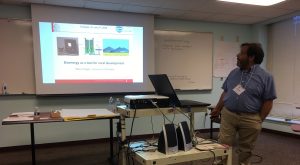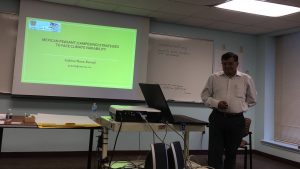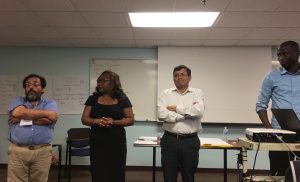Blog Blog Day 1 – June 25, 2018 Blog Day 2 – June 26, 2018 Blog Day 3 – June 27, 2018 Blog Day 4 – June 28, 2018 Blog Day 5 – June 29, 2018 Blog Day 6 – June 30, 2018 Blog Day 7 – July 1, 2018 Blog Day 8 – July 2, Read More ...

ICRPS 2018 Summer Institute | Tuskegee, AL | June 24-July 07
"Social Justice, Rural and Natural Resource Policy"
Written by: Dinesh Dhakal & Merlin Hernandez
We started Day 9 by reviewing what we learned in our last visit of Dekalb County Farmers Market and The Jimmy Carter Presidential Library and Museum. Everybody shared how those two sites are connected to social justice and rural policy. The products available in the farmers market are diverse, fresh and even live. We all believed that farmers are getting market access and fair prices for their products. It was insightful to discover that Jimmy Carter is nurtured by an African American community. This undoubtedly influenced Carter’s approach to social justice and rural policy programs that sought to benefit the poorest sectors of the society. The Carter commitment to human rights and his accomplishments in international peace are some of the exemplary aspects of his presidency.
The sessions were dedicated to policies and programs for indigenous and minority farmers, land owners and communities. Tuskegee Graduate, Miles Robinson who spearheads the USDA Outreach and Assistance for Socially Disadvantaged Farmers and Ranchers, brought a clear grassroots focus to the session in outlining farmer engagement in the process of rural development as an important challenge for African American farmers in the Black Belt South. There is a long history of mistrust of government bureaucracies. Farmers often select themselves out of available programs because they do not believe that they would qualify, do not know about programs or how to access them. Miles’s role is one of outreach and advocacy, and he sits with farmers and their families in the process of building a trust relationship. This allows Miles and his team to provide assistance with farm ownership, loan applications, financial management, technical assistance, and the purchase of operating equipment. There has been some success in creating long-term relationships with retail chains like Walmart.
Philomena De Lima of the University of the Highlands in Scotland sought some clarity on the implications of the link between rural small producers, who are happy to have a ready market for all they can produce, and large food chains who may offer lower prices, and demand costly production improvements and increased capacity. This lowers farmers’ margins and they are forced to reduce costs by lowering wages. Perhaps the most far-reaching casualty of such relationships is that of small farmers outside of the system who cannot price-compete. Philomena saw the issue as one of social justice.
Sara Epp of the Universityof Guelph, Canada used teleconferencing to interact with the delegates to explore The Migration of Mennonite Farmers in Canada from Southern Ontario to the North. There are similarities in the experiences of Southern Black Belt farmers and the Mennonites in terms of high costs of operations and the need for diversified revenue streams. Labor costs are lower for the Canadian groups because of the social and family structures of Mennonite communities. Divergent marketing opportunities, however, see the Mennonite group capturing the markets in the remote communities of Northern Ontario while the farmers of the Black Belt face varying levels of competition.
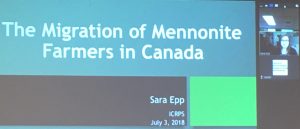
Another Tuskegee graduate, Amadu Diop, Outreach Liaison, USDA Forest Service examined Forestry and Underserved, Socially-Disadvantaged Minority Landowners as well as African American Land-Retention across 13 southern states. For African American landowners, forestry is one of the most important assets that can provide diverse sources of income. There are however, many reasons why forestry fails to provide significant incomes to this community. Those reasons are under-participation in forest management training, decline in African American farm ownership, heir property issues and documentation for inherited lands. Amadu is involved in education, building social networks, legal assistance, and building capacity through linkages with technical and financial assistance.
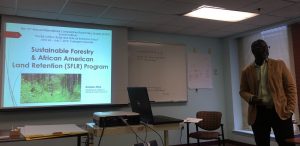
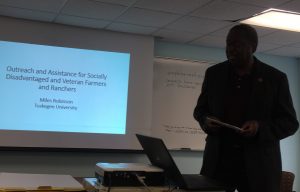
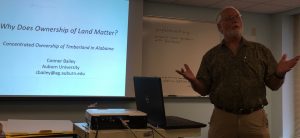

After lunch, participants learned about Natural resources and the environment focusing on minority populations. Conner Bailey, of Auburn University, presented on issues timberland ownership inequality in Alabama State, and how unequal distribution of timberland affects the livelihood of minority population. It is fascinating to know that property tax is lowest in Alabama State among the 50 states of the USA. It would be logical to raise the property tax revenue that can be spent on minority population through the education and health sectors. Souleyman Fall from Tuskegee University highlighted the use of the GIS tool, and how it works as a powerful instrument to create new data in order to do Environmental Justice (EJ) analyses focusing on minority populations. Joseph Quansah, Tuskegee University, discussed the real climate changes in Alabama State and its effects on minority populations. Joseph further outlined potential climate change adaptation strategies in order to mitigate impact on vulnerable communities. Finally, Raymon Shange, Tuskegee University discussed small land owners and rural community outreach program of the Tuskegee University that focuses on food, agriculture and the environment.
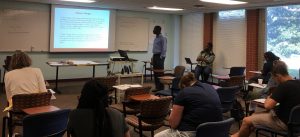
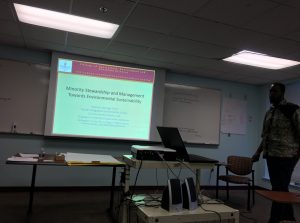
Finally ICRPS finished the afternoon session entitled Climate Change and Environmental Justice with Marco Pagani, University of Bologna who began his presentation with how bioenergy could be used as a means for rural development. Gabino Nava-Bernal, Universidad del Estado de Mexico, explored climate change strategies to deal with climate variability based on field reality and farmers perceptions. Climate change adaptive new cultivars, understanding climate change through time, crop calendar, and crop diversification are some of the important strategies to combat the effects of climate change. The afternoon session ended with the contribution of Catherine Flowers who works as Rural Development Manager for the Equal Justice Initiative. Catherine mentions the problem of inequality in rural social justice in the US. Furthermore, rural development and environmental justice is exacerbated by climate change. Catherine uses the example of Lowndes county and living conditions which are not normally seen in the developed countries. There is the presence of tropical parasites, with deficiencies in health care which are profound social justice issues.
